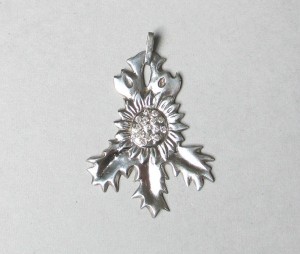 Precious metal clay silver – is it pure silver?
Precious metal clay silver – is it pure silver?
A couple of years ago the answer was “yes, always”. Precious metal clay silver was developed in the early 1990s in Japan by Masaki Morikawa who added a water-soluble, non-toxic, organic binder to microscopic particles of pure silver powder . The binder burns off during firing leaving 999 – silver content metal. The dream of alchemists has come true: dirt becomes precious metal after going through high fire.
However today there are more precious metal clay brands on the market, for instance pmc pro and pmc sterling. These clays result in products of 900- and 925-silver content respectively.
Precious metal clay silver in its purest form has become a popular material among jewellery artists. Mainly because it gives an enormous creative freedom. There are very few things which can go irreversibly wrong. At least before the piece is fired. Precious metal clay silver also allows to make impressions from so many objects: from leaves to ancient patterns. Of course there are other techniques like lost wax casting. But precious metal clay delivers almost immediate results. When shaping precious metal clay pieces you really feel yourself like a sculptor.
However precious metal clay silver has some disadvantages and limitations. For instance, it is quite fragile. Experts say that you should treat objects from precious metal clay silver more like ceramics than metal. It does not mean precious metal clay silver pieces break when they fall. But they are far less solid than traditional sterling silver pieces. This is the reason why sterling silver is used for mechanically loaded parts such as ring shanks and findings. I have written a blog about my experience when and which material – precious metal clay silver or sterling silver – should be used.
Even pmc pro and pmc sterling brands fail to compare to ‘metal’ sterling silver as far as strength is concerned. On the other hand they can no longer claim the ‘absolute’ purity of the traditional PMC precious metal clay silver.
So how can the jewellery designer convince the market that a piece of precious metal clay silver still offers advantages over the traditional “sterling” silver? As far as 999 silver is concerned we can state that purity is still a major advantage. Many people say that they are allergic to silver. Some complain that their skin turns green from wearing silver. What these people react to is not silver, but other metals present in sterling silver, like copper or nickel. In some countries where purity standards are not too strict even more hazardous metals like mercury or lead are added to sterling silver or 9 carat gold (with gold content of less than 40% it is still called gold!).
Porosity of precious metal clay silver could be seen as an advantage too. The pieces are relatively light. They also warm up nicely against the skin. And they just feel good.
Of course the purity argument is not valid as far as pmc pro and pmc sterling clays are concerned. Gorgeous design is in fact the only one argument left, because these clays are not cheap either.
Tastes differ. There are silver wearers and gold wearers. Some prefer industrially produced jewellery, some love handmade. It is nice to have a choice.
